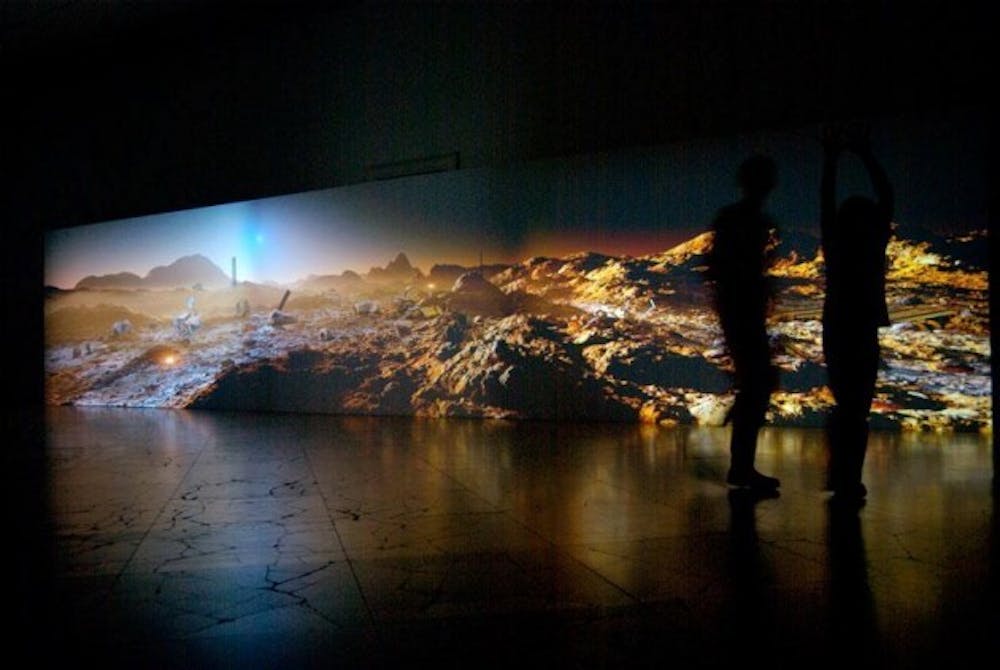Experiencing one of Kelly Richardson's video installations is like stepping into another world - a world where reality and fantasy mesh together to form awe-inspiring and discomforting multi-layered scenes at the same time. In Richardson's work, meteors fall over a tranquil lake, holographic trees fade in and out on a mountainous terrain and ruined space rovers litter a desolate Mars landscape.
Richardson, a Canadian-born artist, explores the relationship between humans and natural settings through the use of large-scale video and sound installations. Richardson is an accomplished artist who has been recognized in the United Kingdom, Canada and the United States. Her work is currently on display at the Albright-Knox Art Gallery in an exhibition entitled Legion, a mid-career survey of her work over the past 15 years, the largest collection of Richardson's works.
From forests and mountains to Mars and the moon, Richardson focuses on documenting existing landscapes or settings and then altering them digitally to create pieces that combine elements of the real and unreal, the natural and manmade.
"It's about our ability to do really great things, like land [the rover], Curiosity, on [Mars]," Richardson said. "But it's also about our destructive nature. We can't help but destroy everything we touch."
Holly E. Hughes, the Albright-Knox curator for the collection, has worked with Richardson and has been an admirer of her work since 2008. That year, they were introduced to each other at a Hallwalls Contemporary Arts Center exhibition. Hughes appreciates Richardson's ability to take a landscape and "transform it and make it feel new" through her digital intervention.
What makes Richardson's work truly stand out, however, is the ability of the installations to present something beautiful yet haunting, making viewers feel conflicting emotions of awe and discomfort.
In Exiles of the Shattered Star, a piece from 2006, asteroids bombard a tranquil lakeside surrounded by mountains. The landscape, which exists in real life, is altered by the invasion of digitally created asteroids combining fiction and reality.
"The added element of the asteroids [is] science fictional, apocalyptic and just stunningly beautiful," Hughes said in an email. "It was the perfect storm. With each work, [Richardson] invents imagery that is at first seductive and lush and recognizable as a landscape, but there is always a hauntingly eerie aspect."
In addition to exploring landscapes people see in nature, Richardson is fascinated with the human desire to explore other planets - most notably Mars. This is illustrated in Richardson's most recent and celebrated work, an installation entitled Mariner 9.
Mariner 9 is a 43-foot wide by 9-foot high video projection of a digital Mars landscape -a scale that allows a full immersion in experiencing the piece. Created with the use of NASA data from previous space missions, Mariner 9 depicts a digital rendering of a futuristic Mars after a century or two of human exploration on the red planet.
The result is a disheveled, desolate wasteland littered with the remains of space rovers, including the Curiosity rover lying broken in the dust. The red and orange landscape is barren and empty, albeit with subtle movements of the space rovers and the dusty wind. Add the ominous, space-like sound that accompanies the installation, and spectators are faced with a truly immersive artwork - a hauntingly beautiful landscape of what Mars may look like in the future.
Lindsay Gabryszak, 30, of Washington, D.C., is fascinated by the questions the work brings up about the future of humanity. She described Mariner 9 as being a "meditative escape or contemplative landscape" because of its overall ambiguity.
"You're still visually going through it to try to determine if this is something that exists presently or an imagination of what might happen in the future," Gabryszak said.
For Richardson, Mariner 9 is a testament to the damaging nature of human beings, according to an interview with ITV News, a U.K. based news network.
Richardson connects deeply to this unforeseen future for the human race; it's an interesting facet of her work because it all portrays the aftermath of the human race whether on Earth or Mars.
"It is a very honest critique on the boisterous nature of mankind, and the assumptions we have made about our existence here, on Earth, and our hierarchy over the natural world," Hughes said in an email. "Her works present a much different scenario - one that is very much void of human presence."
This lack of human presence is another aspect of Richardson's work that is disconcerting. While the altered landscapes are beautiful and evocative, otherworldly and realistic, we become conscious of the fact that maybe our future will not be.
Legion will be on display at the Albright-Knox Art Gallery until June 9.
Email: arts@ubspectrum.com





